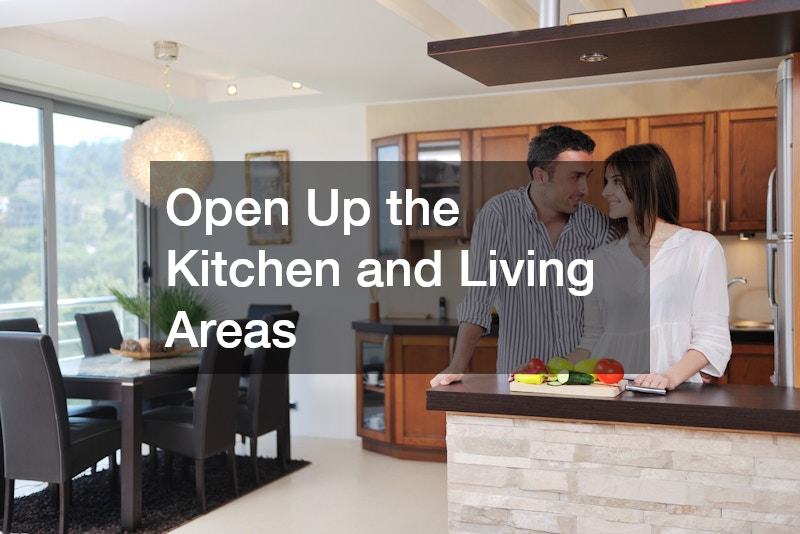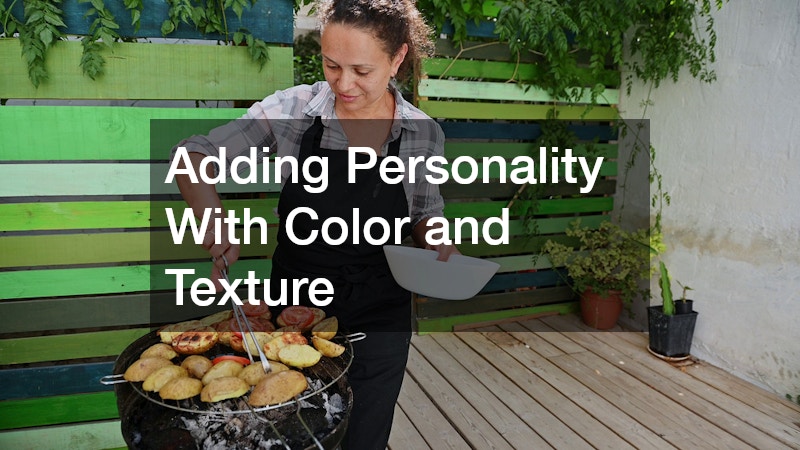There’s something magical about a home where the indoors and outdoors feel connected. Imagine stepping out of your living room and feeling like your backyard is an extension of your home. Achieving that seamless flow doesn’t require tearing down walls—it’s about thoughtful design, functional spaces, and attention to detail. From cozy patios to well-lit pathways, you can create an environment that invites both comfort and style.
A seamless indoor-outdoor connection also adds value to your home and improves everyday living. Natural light, fresh air, and open sightlines make interiors feel more spacious and inviting, while the outdoor environment becomes more functional and welcoming. Families can enjoy cooking, dining, or relaxing outside while staying connected to the interior. Children can move safely between indoor and outdoor spaces, and entertaining friends becomes effortless when the layout feels open and intentional.
To get started, think about how your lifestyle interacts with your home. Do you spend most of your time in the kitchen or living area? Do you entertain frequently, or is your outdoor space mostly for quiet enjoyment? Having clarity on these habits will inform decisions on furniture placement, door types, and landscaping. Planning for seasonal changes is also key, as extending the indoor-outdoor flow through pergolas, shade structures, or retractable doors ensures year-round usability. Small, thoughtful upgrades can dramatically enhance the experience without requiring massive construction.
Start With a Vision

Before you pick materials or plan renovations, it’s important to have a clear vision of how you want your spaces to interact. Imagine walking through your home and naturally flowing from the living room to a patio, from a dining area to a backyard garden, or from a kitchen to an outdoor dining nook. Understanding how people will move, gather, and interact with each space is critical to designing a seamless experience. A well-defined vision also helps prioritize improvements and ensures every addition serves the overall goal.
Many homeowners choose to begin with home renovation projects to open up layouts and create larger sightlines. Removing walls, widening doorways, or adding windows not only improves natural light but also strengthens the connection between indoor and outdoor spaces. Even minor updates, such as repositioning furniture or reconfiguring a seating arrangement, can dramatically improve flow. Additionally, a cohesive vision can guide exterior decisions, including landscaping, lighting, and patio placement, so that the outdoor space complements interior design rather than feeling disconnected.
A clear vision also reduces costly mistakes. By planning carefully, you can anticipate potential challenges, such as privacy concerns, shade needs, or traffic flow. Consulting professionals early in the process ensures that structural changes, electrical work, and material choices align with your vision. Professionals offering remodeling service can help translate ideas into practical solutions while keeping the project organized and manageable. With a strong vision as your foundation, the rest of your design choices will fall into place naturally.
Use Materials That Bridge the Gap
When designing for indoor-outdoor flow, continuity of materials is key. Using similar textures, colors, and finishes inside and outside makes transitions feel intentional and effortless. Stone, wood, and high-quality composite materials work beautifully for both patios and interior floors, creating a cohesive look without being overly matchy. Smooth, polished surfaces can continue from the kitchen to a deck, or a warm wooden finish inside can complement outdoor pergolas, planters, and walkways.
Attention to detail is crucial. Outdoor surfaces need to be durable and weather-resistant, while interiors benefit from warmth and comfort. Finding materials that satisfy both requirements requires planning and sometimes professional guidance. Many homeowners hire a remodeling service to coordinate these updates, ensuring that indoor flooring, outdoor decks, and patios complement each other without compromising durability. Matching materials subtly rather than exactly often produces the most elegant effect, blending spaces naturally while maintaining functional integrity.
In addition, small touches make a big difference. Using coordinated accent colors, repeating patterns, or consistent trim helps tie spaces together visually. Even outdoor structures, such as seating walls or pergolas, can echo interior design cues, reinforcing the flow. When you consider every surface, from floors and walls to countertops and garden beds, the materials you choose act as connectors between indoors and outdoors, turning separate areas into a harmonious whole.
Open Up the Kitchen and Living Areas

The kitchen and living areas are often the heart of the home, and they naturally lend themselves to indoor-outdoor connections. Opening up these spaces with sliding glass doors, folding panels, or oversized windows can flood interiors with light while making it easy to step outside. By carefully planning bathroom renovations, you can also improve natural light and sightlines in adjacent spaces, contributing to a brighter, more connected feel throughout the home.
Functionality is as important as style. A kitchen that flows to an outdoor dining area makes entertaining easier and more enjoyable. Guests can mingle while you prepare meals, and family members can seamlessly move between indoor cooking and outdoor play. Similarly, living rooms benefit from layouts that encourage movement toward outdoor areas. Arranging furniture in a way that guides traffic toward patios or decks helps unify the spaces naturally, while keeping them functional and comfortable.
Lighting, furniture, and color coordination all play a role. A consistent palette between indoor and outdoor furnishings creates visual harmony, and using textures that feel comfortable both inside and outside reinforces the sense of flow. Professionals offering interior painters can ensure walls and trim complement outdoor finishes, while designers can advise on how to balance aesthetics with practicality. By thoughtfully opening up kitchens and living spaces, your home can feel larger, brighter, and more inviting while creating a seamless indoor-outdoor experience.
Enhance the Outdoors With Functional Additions
Outdoor spaces should feel as purposeful as the interior. Adding functional features such as pergolas, outdoor kitchens, seating areas, or fire pits transforms the backyard from a simple lawn into a true extension of your home. Covered spaces provide protection from sun and rain, making the outdoors usable year-round. Incorporating built-in seating, storage, or multipurpose areas ensures that the exterior remains as functional as the interior spaces.
Outdoor upgrades also include practical considerations, such as drainage, flooring durability, and maintenance. Incorporating resilient materials and thoughtful landscaping helps prevent wear and ensures longevity. Adding ornamental iron gates along pathways or at entry points not only elevates style but also defines boundaries, guiding movement while enhancing safety and security. These decorative elements connect interior aesthetics with outdoor charm.
If you are planning structural improvements, professionals offering roofing services can ensure that outdoor coverings are both protective and visually appealing. Roofing elements like pergola tops, retractable awnings, or shade structures create outdoor rooms that feel intentional. By combining aesthetic and functional improvements, you can create outdoor spaces that are enjoyable, practical, and cohesive with the interior of your home, reinforcing the seamless flow between indoors and outdoors.
Lighting That Connects Inside and Out

Lighting is one of the most powerful tools for unifying indoor and outdoor spaces. It shapes perception, highlights features, and guides movement. Inside, soft, ambient lighting enhances comfort and warmth. Outdoors, well-placed landscape lighting services illuminate pathways, patios, and garden areas, creating an inviting environment that feels like an extension of your living space.
Layering light sources, including pendant lights, wall sconces, recessed lighting, and subtle ground-level fixtures, helps create continuity. Highlighting key elements such as water features, trees, or architectural details ensures that the design feels intentional rather than fragmented. Proper illumination also extends usability, allowing for evening entertaining and creating ambiance.
Lighting can also be used to accentuate flow between spaces. Placing fixtures strategically near doors, windows, and transitions guides people naturally from one area to another. Outdoor lighting should complement interior tones, so the effect is seamless when viewed from inside. Professionals offering landscape lighting services can help design systems that are both functional and visually striking, reinforcing the connection between your home and the surrounding environment while enhancing safety and curb appeal.
Comfort and Functionality Matter
A home with seamless indoor-outdoor flow must be comfortable and functional. Comfortable furniture, clear pathways, and well-thought-out shading make outdoor areas inviting for everyday use. Adding functional elements like built-in seating, storage, or retractable covers enhances usability and encourages frequent outdoor activity. Integrating features like pool services can create focal points for relaxation and entertainment, further connecting indoor enjoyment with outdoor experiences.
Maintaining outdoor spaces is equally important. Professionals offering lawn services can ensure that lawns are lush, pathways are clear, and planting beds are maintained, creating a clean and welcoming backdrop for outdoor living. Proper upkeep encourages residents to spend more time outdoors, strengthening the connection with the interior. Trees, shrubs, and flowering plants also contribute to privacy, beauty, and comfort, framing the home and creating a sense of enclosure without sacrificing openness.
Design choices, from seating to material selection, should always prioritize ease of use and enjoyment. Outdoor cushions, rugs, and furniture should be durable yet comfortable, complementing interior finishes. By balancing aesthetics with functionality, your home becomes an environment that naturally invites people to move between spaces and enjoy every part of the property seamlessly.
Adding Personality With Color and Texture

Color and texture help unify indoor and outdoor spaces. Using complementary palettes across furniture, finishes, and landscaping reinforces the sense of continuity. Warm tones inside can echo wood, stone, or greenery outside, creating visual harmony. Textured surfaces, from woven rugs and cushions to stone countertops or deck finishes, add depth and richness to both environments.
Professional interior painters can ensure that walls, trim, and doors harmonize with outdoor tones, enhancing continuity. Accents such as coordinated cushions, outdoor rugs, or planters further extend interior aesthetics to exterior spaces. Even small decorative items, like sculptures or lanterns, can mirror interior design elements, reinforcing cohesion.
Texture is equally important. Mixing smooth, polished surfaces with natural, tactile materials creates balance while maintaining flow. For example, a polished wooden floor inside can pair beautifully with a wooden deck outside. Layering texture and color thoughtfully ensures that the transition between interior and exterior feels seamless and intentional.
Maintenance and Longevity
A seamless indoor-outdoor design is only effective if both areas are well-maintained. Outdoor surfaces, pathways, and driveways benefit from periodic upkeep, and working with local asphalt contractors ensures smooth, safe transitions. Roofs and gutters require inspections to prevent damage and maintain aesthetic appeal, while interior surfaces need regular cleaning and minor touch-ups.
Routine maintenance protects your investment and preserves the design vision. Scheduling inspections for outdoor features, from decks to lighting and gates, prevents deterioration. Similarly, interior upkeep, such as refreshing paint or checking for wear in high-traffic areas, keeps spaces aligned with outdoor improvements. Coordinating care across both environments ensures a cohesive, long-lasting indoor-outdoor experience.
The Role of Landscaping
Landscaping acts as a bridge between indoor and outdoor living. Thoughtful selection of plants, garden beds, and hardscaping elements creates a natural flow. Native plants reduce maintenance while blending your property into its surroundings, and well-placed furniture, lighting, and pathways increase usability.
Landscape lighting services can highlight key design elements at night, ensuring the greenery remains bright and inviting. Pathways, patios, and seating areas should be arranged to encourage movement and interaction, making outdoor spaces feel like a natural continuation of interior rooms. Landscaping doesn’t just look good—it shapes how people experience and move through your home.
Create Zones for Multiple Activities
Indoor-outdoor flow works best when spaces are organized into zones. A deck can serve as a dining area, while a separate patio hosts relaxation or entertainment. This approach ensures functionality without sacrificing flow. Professional remodeling service providers can design zones that feel connected yet purposeful, creating intuitive movement between spaces.
Each zone can have its own character while harmonizing with the overall design. Strategic furniture placement, complementary textures, and consistent color palettes help unify zones. By planning zones carefully, your home becomes versatile and inviting, accommodating multiple activities simultaneously while maintaining a seamless indoor-outdoor connection.
Small details make a major difference. Coordinating furniture, cushions, and accent pieces across indoor and outdoor spaces reinforces cohesion. Thoughtful accents, such as outdoor rugs and planters, reflect interior textures and finishes, ensuring harmony between environments. By balancing style, function, and professional craftsmanship, you can create an inviting, practical, and beautiful home that flows naturally indoors and outdoors.
